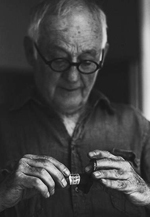

Australian figurative and surrealist painter Peter Booth was born on November 2 1940 in Sheffield, England. Widely acclaimed as one of the most significant late twentieth century Australian artists, Booth’s work is characterized by a powerful emotive force of dark narrative and obscure symbolism.
As the son of a steelworker, Sheffield’s bleak industrial environs had a significant impact on Booth from an early age. He took up drawing classes at the Sheffield College of Art from 1956 to 1957. After migrating to Australia with his family in 1958, Booth initially found work as a labourer before enrolling in the National Gallery School in Melbourne where he studied painting until 1965. In 1964 Booth was awarded the prize for subject painting and was joint winner of the Bernard Hall prize for figure painting. From 1965 to 1969 Booth taught painting at the Prahran Technical College in Melbourne and held his first solo exhibition at Pinacotheca in Melbourne and also exhibited at the Central Street Gallery in Sydney.
In 1968, The Field exhibition included one of Booth’s large minimalist geometric abstractions. To mark the opening of the new National Gallery of Victoria in St. Kilda Road, this exhibition featured the work of forty young emerging artists who had turned away from figurative art to the 20th century trends of American abstraction: most notably colourfield, hard-edge minimalism and op art.
Booth’s early paintings were hard-edge abstract works, with black dominating his paintings by 1971. The artist used black to portray social isolation and related the dark colour with the industrial landscapes remembered from his native Sheffield. In 1971 the most significant of Booth’s early 1970s ‘doorway paintings’ was acquired by the National Gallery of Victoria.
By the late 1970s Booth had become a painter of powerful expressionist images, reinventing his dreams on the canvas. Booth returned to a labouring job before taking up a position as technical assistant at the National Gallery of Victoria until 1975. He taught again in 1975 and 1976. In 1976 the Art Gallery of New South Wales made Peter Booth’s work the subject of its Project 12 exhibition. In 1977 Booth first exhibited large figurative paintings. These powerfully painted works portrayed scenes of devastation inhabited by figures drifting around and often in the company of animals, in particular a manifestation of his much loved bull terriers.
In the 1980s Booth began his phase of gruesome works depicting mutilated bodies and war scenes, sometimes counter-balancing the horror with gentle humour. Inherent throughout Booth’s art is strength of feeling, drawing the viewer into the emotions of the characters. The artist’s landscapes were dominated by people featuring mutants and mythological beings often attacked by beasts. In later works groups of men stood around, as though waiting for something menacing to happen.
Booth's Australian landscapes reflect the artist’s preoccupation with man’s relationship with the environment. He explores the implications of the individual’s capacity to create and destroy and the future impact on both urban and rural landscapes. Through his art, Booth also questions how the world may evolve, with humans as mutants. Emotion and symbolism are powerful features of his landscapes. The artist draws upon his earliest memories as a young boy growing up in the blackened wasteland of industrial Sheffield. His apocalyptic figurative paintings are infused with a powerful image of anxiety, bringing to mind the dreadful aftermath of destruction. Ominous forms and bold brushstrokes convey restlessness and anxiety.
From 1983 to 1986 Booth was senior lecturer in painting at the Victorian College for the Arts, when he returned to painting full-time. He now lives and paints in the bayside suburb of St Kilda in Melbourne. Peter Booth has had numerous gallery and museum exhibitions, including a major retrospective exhibition of his work at the Ian Potter Centre, National Gallery of Victoria from November 2003 to February 2004.
Booth’s art is represented in most major Australian art museums. The National Gallery of Victoria has representation of his painting since the late 1960s. The AGNSW, the AGSA and the National Gallery of Australia hold significant examples of Peter Booth’s painting, and representative collections of his works on paper. Peter Booth enjoys an international reputation as one of the most inspired and influential contemporary Australian artists. His work is integral to the history of late twentieth century Australian art. Booth’s work has received constant critical acclaim for its stunningly powerful imagery and the emotional strength of its inexplicable, intricate and often disquieting narratives.
Copyright © 2007 Abstract Australis. All rights reserved. Click here to view copyright statement